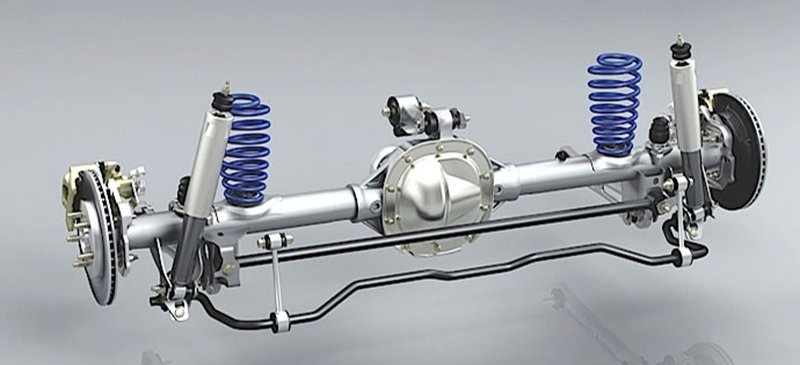Table of Contents
ToggleWhat is a Car Suspension System?
A car suspension system is a collection of components that connect a vehicle’s wheels to its body. It works to absorb the impact of road irregularities, such as potholes, bumps, and uneven surfaces, while maintaining contact between the tires and the road. The system also plays a key role in improving handling and vehicle control, especially during cornering or high-speed driving.
The main goal of a suspension system is to ensure that the tires maintain optimal traction with the road, which directly impacts the vehicle’s safety, performance, and comfort.
Key Components of a Suspension System
While there are different types of suspension systems, most share a common set of components. Let’s take a look at the primary parts involved:
1. Springs
Springs are a critical component of the suspension system, as they absorb the energy from road shocks. There are several types of springs used in suspension systems, each with unique characteristics.
- Coil Springs: The most common type of spring, they are made of tightly wound steel coils and are used in most modern vehicles.
- Leaf Springs: These are typically found in older vehicles and commercial trucks. They consist of layers of metal that are curved and used to absorb shock and support the weight of the vehicle.
- Air Springs: Often used in air suspension systems, these springs are made of rubber and filled with compressed air, offering adjustable ride height and firmness.
2. Shock Absorbers
Shock absorbers are designed to control the spring’s movement and dampen the oscillations that occur after hitting a bump. They reduce the bounce of the car and ensure that the tires stay in contact with the road for better handling.
Shock absorbers contain hydraulic fluid that works by compressing and decompressing through valves, converting kinetic energy from road shocks into heat, which is then dissipated.
3. Struts
Struts are a critical component of many modern suspension systems, particularly MacPherson strut systems. A strut combines the function of a shock absorber and a spring into one unit, providing support for the vehicle’s weight and helping to absorb shocks from the road.
In addition to acting as a shock absorber, struts also play an integral role in vehicle alignment and help reduce the amount of space required for the suspension system.
4. Control Arms
Control arms are responsible for connecting the suspension components to the vehicle’s frame. They provide stability and allow the wheels to move up and down while keeping them properly aligned with the vehicle.
Control arms typically consist of a metal arm with bushings at both ends to allow for flexibility while maintaining stability.
5. Bushings
Bushings are small rubber or polyurethane parts that cushion the movement between components in the suspension system, such as between the control arms and the vehicle’s frame. These bushings reduce friction and noise while providing added flexibility and comfort during driving.
6. Ball Joints
Ball joints allow the www.truthin24.com/ to move smoothly and provide flexibility when steering and driving over bumps. They are crucial for proper steering geometry and allow the wheels to pivot while maintaining their connection to the suspension.
7. Stabilizer Bar (Anti-Roll Bar)
The stabilizer bar, or anti-roll bar, helps reduce body roll when the car turns. It connects the left and right sides of the suspension to evenly distribute the weight, preventing excessive tilting of the car during sharp turns.
Types of Car Suspension Systems
There are several different types of suspension systems, each designed for different vehicle needs. Below are the most common types:
1. Independent Suspension
In an independent suspension system, each wheel on the axle moves independently of the others. This system provides better handling and a smoother ride because the wheels are not interconnected. When one wheel goes over a bump, the other wheel is not affected.
Advantages:
- Improved handling and comfort.
- Better traction, especially in uneven terrain.
- Better performance in terms of shock absorption.
Types of Independent Suspension:
- MacPherson Strut: A common independent suspension system used in front-wheel drive vehicles. It combines a shock absorber and spring into one unit and uses fewer components.
- Double Wishbone: Found in sports cars and some luxury vehicles, this system uses two arms to control wheel movement and allows for precise handling and improved cornering.
2. Dependent Suspension
In a dependent suspension system, both wheels on the axle are linked together and move in unison. When one wheel goes over a bump, the other is affected. This type of suspension is usually found in the rear of trucks and larger vehicles.
Advantages:
- Simpler design and more cost-effective.
- Often found in heavy-duty vehicles that carry heavy loads.
Disadvantages:
- Less comfort and handling compared to independent suspension.
Types of Dependent Suspension:
- Solid Axle: Common in rear-wheel drive vehicles and trucks. A solid axle allows for heavy-duty capabilities, making it ideal for off-road vehicles.
- Leaf Spring Suspension: Often used in combination with solid axles, leaf springs provide a durable, load-bearing option for larger vehicles.
3. Air Suspension
Air suspension uses air-filled bags instead of metal springs to provide a smoother ride. This type of suspension is often adjustable, allowing for changes in ride height and firmness. Air suspension is typically found in luxury cars, trucks, and commercial vehicles.
Advantages:
- Adjustable ride height and firmness.
- Excellent for comfort and reducing road noise.
- Better for towing and load-bearing.
Disadvantages:
- Expensive to repair and maintain.
- Can be prone to leaks or mechanical failures.
4. Hydraulic Suspension
Hydraulic suspension systems use fluid-filled cylinders to control the ride quality and suspension stiffness. This system is used in some high-end vehicles and provides adjustable ride characteristics based on driving conditions.
Advantages:
- Superior ride quality and handling.
- Can be used to adjust vehicle height and firmness on demand.
Disadvantages:
- Expensive to maintain and repair.
- More complex compared to traditional systems.
How Does a Suspension System Work?
The suspension system works by absorbing shocks from the road, maintaining tire contact, and ensuring that the vehicle remains stable. Here’s a simplified breakdown of how the system functions:
-
Shock Absorption: When the vehicle encounters bumps, potholes, or uneven surfaces, the suspension springs compress and absorb the impact. This reduces the force transferred to the rest of the vehicle, providing a smoother ride.
-
Damping: Shock absorbers control the compression and rebound of the springs. They prevent the car from continuing to bounce after hitting a bump, ensuring a stable and controlled ride.
-
Handling: The suspension system also plays a critical role in how the car handles. It allows for smooth cornering by maintaining the tires’ contact with the road. Suspension components like control arms and stabilizer bars contribute to stability during turns.
-
Weight Distribution: The suspension system helps distribute the vehicle’s weight evenly, ensuring that the tires maintain proper contact with the road. This is especially important for preventing skidding and improving traction.
Why is the Suspension System Important?
1. Ride Comfort
A well-functioning suspension system ensures that you enjoy a smooth ride, even when driving on rough or uneven roads. It absorbs shocks and vibrations, preventing them from being transferred to the cabin.
2. Vehicle Handling
The suspension system is critical for vehicle handling. It enables precise steering, better cornering, and stability during braking, all of which are essential for a safe driving experience.
3. Safety
A properly maintained suspension system ensures that the vehicle maintains optimal contact with the road, reducing the risk of accidents due to skidding or loss of control. The suspension also helps in evenly distributing the vehicle’s weight, improving braking and traction.
4. Tire Wear
The suspension system plays a vital role in ensuring that the tires wear evenly. Uneven wear due to poor suspension can affect vehicle handling, reduce tire life, and increase the need for premature tire replacements.
Signs of Suspension System Problems
Suspension problems can arise over time due to wear and tear. Common signs of suspension issues include:
- Uneven Tire Wear: If your tires are wearing unevenly, it could be a sign of suspension misalignment.
- Bumpy or Rough Ride: If your ride feels unusually harsh or you experience excessive bouncing, it could indicate a suspension issue.
- Difficulty Steering or Handling: If your vehicle pulls to one side or feels unstable during turns, your suspension may be compromised.
- Noises: Clunking or squeaking sounds when driving over bumps often indicate worn suspension components.
If you notice any of these symptoms, it’s important to have your suspension system checked by a professional mechanic.
Conclusion
The suspension system is an integral part of any vehicle, ensuring comfort, safety, and optimal performance. By understanding its components, types, and how it works, car owners can better maintain their vehicles and identify issues before they become serious problems. Regular maintenance and inspection of the suspension system are key to ensuring a smooth, safe, and enjoyable driving experience for years to come.










